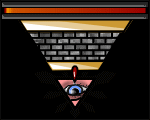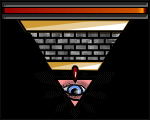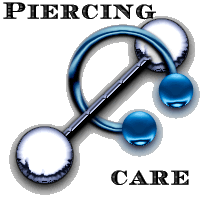Tattoo Aftercare, Piercing Aftercare, Oral Piercing Aftercare.
Piercings Below the neck Piercings Above the neck Labret, Lip, and Tongue Piercings
WE ARE NOT PHYSICIANS AND THIS IS NOT A CLINICAL PRESCRIPTION. THESE ARE RECOMMENDATIONS BASED ON PAST EXPERIENCE AND MAY NOT BE RIGHT FOR YOU.
Basic Piercing Care
Healing time for piercings varies greatly from piercing to piercing and from person to person. Some people assume they can remove their jewelry at any time and reinsert it easily. This is not the case. Something must be left in the piercing at all times for at least the first six months, a year is even better. While most people are sufficiently healed at this point to be able to leave their jewelry out and reinsert it later with minimal difficulty, a few will lose the piercing altogether if the jewelry is left out for more than the briefeest period of time. Caution and some experimentation are suggested.
Even though superficially healed, some time is required for a piercing to season and "toughen up" if the jewelry must be removed for a short period of time during the first few months. Clean the piercing as described below and insert a retainer. This is virtually undetectable, particularly to x ray and will help keep the piercing open until the jewelry can be reinserted. To ease reinsertion, use an insertion taper lubricated with a little Bacitracin ointment or Johnson & Johnson First Aid cream.
If your piercing was done properly and you conscientously attend to the aftercare, your risk of infection is minimal. In our experience, most problems are caused by 1) oral contact or handling your piercing with unwashed hands, 2) using a cleaning agent which isn't compatible with your body, 3) overcleaning or not cleaning the piercing properly, or 4) wearing jewelry to which you are allergic or which is not appropriate in material size or design for your particular piercing. If you have any healing problems, we will be happy to help you in any way we can.
However, please understand we are not physicians. We can only offer suggestions based upon our experience. If those suggestions do not produce a rapid improvement, a physician should be consulted as soon as possible. Crusting during the healing process is normal and no cause for concern. Itching, rash, discharge of clear fluid, and enlargement of the piercing usually indicate an allergic reaction; either to the cleaning agent or the material the jewelry is made of. Signs of an infection are swelling, pain, excessive redness and/or discharge of pus. Removing your jewelry will not necessarily end an infection and may, in fact, make matters worse by eliminating a passageway for the discharge of pus and matter. If possible, leave your jewelry in when consulting your physician.
The aftercare you give your piercing will determine how quickly and how well it heals. It's important to do everything possible to avoid an infection. The following information will provide some general guidelines for the care of your new piercing:
Thoroughly clean your new piercing twice daily. Overcleaning and using too many different cleaning/healing agents at once can create problems, so don't switch unless you are having problems.
Piercings Below the Neck. (back to top)
No single cleaning product is perfect for everyone. Try a liquid antibacterial soap (if you have sensitive skin avoid products with fragrance & coloring). Check out Dial, Soft Soap, Phisoderm, or Johnson's No More Germies.
The first step in cleaning is to wash your hands thoroughly. Then, using warm water and a little cleansing agent, remove all dried matter from the surface of the ring and around the opening of the piercing. A small amount of cleaning agent is placed on the piercing, lathered up and the ring worked back and forth through the piercing half a dozen times. Leave the cleaner in contact with the skin for about three minutes. Finally, rinse thoroughly under running water, again working the jewelry back and forth at least six times.
The effectiveness of antibiotic ointments and oral antibiotics depends upon selecting the right one for the job. This is something that should be left to a physician. If you have used an over the counter ointment without any advers reation, it is probably safe for no more than three to five days used sparingly. Bacitracin is the least likely to cause problems.
As a general rule, rubbing alcohol and hydrogen peroxide don't work well. They tend to be very drying and can slow the healing process by destroying new healthy skin cells.
To help your body fight infection and heal itself more quickly, get plenty of rest. Try to reduce your stress level, eat a nutritious diet, and, if possible, take some form of multivitamin/mineral supplement. Several medical professionals have suggested taking a zinc supplement. Daily dosage for women would be one 60mg. tablet, and two tablets for men. Unless your doctor advises otherwise, discontinue use after four weeks. Also suggested is a 3000mg tablet of vitamin c daily. This should be in mineral ascorbate form, not ascorbic acid which can upset your stomach. Emergen-C is excellent, one packet three times daily. Keep saliva & other body fluids (from either your partner or yourself) out of your piercing.
Finally, don't get rough with your new piercing. If you do play with it, be gentle.
Most Piercings Above the Neck (back to top)
Cleaning products for piercings below the neck are generally too harsh for those above. Consider a product containing the antiseptic benzalkonium (or benzalthonium) chloride. One sold as ear piercing antiseptic but useful for all piercings above the neck, is available at some ear piercing boutiques. Alternatives include Johnson & Johnson's No More Ouchies or Bactine. If too harsh, these can be diluted up to 50/50 with water.
Twice daily after washing your hands, use a cotton swab saturated with the solution to remove any dried matter, then work some of the solution into the piercing, rotating the jewelry if necessary.










